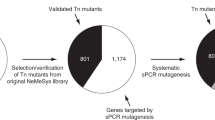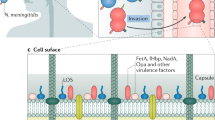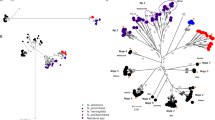Abstract
The pathogenic bacterium Neisseria meningitidis is an important cause of septicemia and meningitis, especially in childhood1. The establishment and maintenance of bacteremic infection is a pre-requisite for all the pathological sequelae of meningococcal infection. To further understand the genetic basis of this essential step in pathogenesis, we analyzed a library of 2,850 insertional mutants of N. meningitidis for their capacity to cause systemic infection in an infant rat model. The library was constructed by in vitro modification of Neisseria genomic DNA with the purified components of Tn10 transposition2. We identified 73 genes in the N. meningitidis genome that are essential for bacteremic disease. Eight insertions were in genes encoding known pathogenicity factors. Involvement of the remaining 65 genes in meningocoocal pathogenesis has not been demonstrated previously, and the identification of these genes provides insights into the pathogenic mechanisms that underlie meningococcal infection. Our results provide a genome-wide analysis of the attributes of N. meningitidis required for disseminated infection, and may lead to new interventions to prevent and treat meningococcal infection.
Similar content being viewed by others
Main
The publication of the complete genome sequence of two Neisseria meningitidis isolates has provided a comprehensive profile of the genetic complement of this important pathogen3,4. However, the genome sequences emphasize inadequacies in our understanding of meningococcal pathogenesis. For example, it is not known which of the 2,158 N. meningitidis genes are involved in the disease process, and a substantial proportion of the open reading frames (ORFs) have no known function. Therefore, methods for high-throughput analysis of gene function are needed to exploit the information from the genome projects.
We used signature-tagged mutagenesis5 (STM) of N. meningitidis to identify genes essential for septicemic infection. In STM, individual mutants are tagged with unique sequence identifiers, allowing large numbers of mutants to be analyzed simultaneously. However, for STM it is necessary to construct libraries of insertional mutants, so far a limitation in studying N. meningitidis. We successfully accomplished mutagenesis using a new method in which Neisseria DNA is modified in vitro using purified components of Tn10 transposition. As N. meningitidis efficiently takes up exogenous DNA (ref. 6), the modified alleles are then introduced into N. meningitidis by transformation. We screened the mutants for their ability to cause systemic infection. Here we identified 73 genes involved in septicemic disease, including 16 of previously unknown function.
We used pSTM115 (Fig. 1a) as the transposon donor for in vitro mutagenesis. We included 96 pSTM115 derivatives, each containing unique signature tags (fig, 1b), in 96 separate transposition reactions. The modified genomic DNA was repaired, and returned to the host by transformation. We selected 30 mutants from each reaction, resulting in a library of 2,880 mutants (30 pools × 96). To determine whether Tn10 insertion occurs at diverse sites, we assessed 40 transformants from a single transposition reaction by Southern blot analysis. Each had a single, distinct Tn10 insertion (Fig. 1 c). To establish whether Tn10 integration was stable during systemic infection of infant rats, we compared the hybridization patterns of six mutants before and after passage through rats. We obtained identical hybridization patterns before and after infection (Fig. 1 d).
a, The insert of pSTM115 includes the 70-base-pair 'outside (O) ends' of Tn10 flanking the kanamycin resistance marker (kanR), a copy of Neisseria DNA uptake sequences (NUS) and the origin of replication (ori) from pACYC184. b, PCR blots were probed with tags amplified from the middle three rows of 96 pSTM115-derivatives in a microtiter plate. c, Southern blot analysis of N. meningitidis mutants. A single integration of the transposon reaction generates two hybridizing bands because of a ClaI site in the kanamycin resistance cassette; doublets are present in lanes 2, 3 and 14. d, The hybridization pattern obtained from six mutants before (I) and 20 h after (O) inoculation of 5-day-old infant rats. Right margin (c and d), molecular sizes (1-kb ladder). e, The level of bacteremia after intraperitoneal inoculation of rats with bacteria. Inocula: 5 × 107 CFU (○), 5 × 106 CFU (▴) or 5 × 105 CFU (□).
Pilot experiments established that infant rats given 5 × 106 colony-forming units (CFU) intraperitoneally had sustained bacteremia for 32–48 hours, with peak levels reaching 1 × 106–1 × 107 CFU/ml at 18 hours (Fig. 1e). We used a two-stage strategy to identify attenuated mutants ( fig. 1f). We screened 2,850 mutants in duplicate, in pools of 95 mutants, at a total dose of 1 × 107 CFU. We recovered bacteria from the blood of infected rats 20–24 hours later. Using comparative hybridization of the tags in the inoculum with those in bacteria recovered from the rats, we identified 234 putatively attenuated mutants; results from rats given the same inoculum were highly reproducible.
Certain cell surface structures expressed by N. meningitidis are involved in pathogenesis and are subject to high-frequency, 'on–off' switching7. Thus, the failure of a mutant to establish systemic infection might result from a phase variation event. We used a second round of verification to exclude this possibility. We backcrossed each mutation into the parental strain, and tested the newly constructed mutants in STM pools; 108 mutants had reduced hybridization signals in both rounds of screening.
We determined the nucleotide sequence of regions flanking the transposon in the 108 attenuated mutants. Each transposon was inserted at a distinct site, although in some cases more than one mutant had a transposon in the same gene. Thus, 73 ORFs contained transposons, and 11 insertions were located in intergenic regions. To confirm their attenuated phenotype, we tested 22 mutants in direct competition with the wild-type isolate for their ability to cause systemic infection. All mutants had substantially attenuated survival in the host.
The identification of mutants with insertions in genes encoding previously defined virulence determinants validates the approach used in the study. These mutants were affected in the biosynthesis of capsular polysaccharide, lipopolysaccharide and iron acquisition molecules. Involvement of the remaining 65 genes identified have not been previously shown to be involved in N. meningitidis pathogenesis (Table 1), and therefore provide new insights into the basis of meningococcal septicemia (Table 1).
Bacteria have evolved sophisticated mechanisms to sense and respond to specific environmental cues. However, nothing is known about the regulatory networks governing gene expression during meningococcal pathogenesis. Two genes were identified (ntrY and hfq) that potentially affect transcription at many loci. NtrY is a putative sensor of a two-component regulator, NtrX/NtrY (ref. 8), whereas Hfq is related to host factor 1, which influences mRNA stability in Escherichia coli9. The recognition that hfq and ntrY are required for meningococcal sepsis provides a starting point for investigating the coordinated regulation of gene expression during pathogenesis.
Seven mutants have insertions in genes responsible for integrity of the cell envelope, including four involved in peptidoglycan metabolism, the target of β-lactams, the main agents used to treat meningococcal infection. Here we have identified many genes involved in amino-acid biosynthesis, including five in the shikimate pathway, which has been widely exploited for vaccine development10,11. We also identified ORFs encoding surface-associated proteins with potential transport functions. Two putative ATP-binding cassette transporters were required for invasive infection. One of these (NMB1612) was closely related to the histidine-binding component of a transporter in E. coli12. The substrate for the other ATP-binding cassette transporter (NMB1240) is unknown.
Although the positions of attenuating mutations were widely distributed throughout the serogroup B N. meningitidis genome, we identified two clusters. The first contained insertions in three genes responsible for iron transport (NMB1728–1730), and one upstream of NMB1988 encoded an iron-regulated outer membrane protein. A second group of eight mutants (NMB1954–2006) included insertions in four genes of unknown function.
Comparison of the two completed N. meningitidis genome sequences showed that 8.8% of the serogroup B ORFs have no homolog in serogroup A (ref. 4). Of the 73 ORFs we identified, four were not present in serogroup A. Three encode proteins of unknown function ( Table 2), whereas the other (NMB067) is necessary for capsular polysaccharide biosynthesis in serogroup B only. Most ORFs required for N. meningitidis bacteremia have related sequences in the partial N. gonorrhoeae genome. This is not unexpected, given the genetic relatedness of these species, and that N. gonorrhoeae can occasionally cause disseminated infection. To determine whether the genes of unknown function identified by STM are conserved, we examined their distribution in complete genomes of other organisms. Six ORFs did not have homologs (BLASTP e<10−5) in the other microbes examined, whereas four were conserved across bacterial genera (Table 2).
Polar effects on downstream genes can complicate the analysis of transposon mutants. To establish whether the transposon insertions are likely to have polar effects, we examined the serogroup B genome to predict whether the transposon is located in a potential operon. Polar effects were possible in 14 mutants, but as most operons contain groups of functionally related genes, these insertions remained informative.
We used a genome-wide functional analysis of N. meningitidis to identify genes required for septicemia. The approach differs fundamentally from the sequence-based methods that have been used to compile lists of 'pathogenicity genes' in this bacterium4. Such lists inevitably contain discrepancies that arise from subjective views of definitions and of the strength of evidence supporting the involvement of a gene product in pathogenesis. Functional approaches to gene identification have the advantage of being unbiased and less reliant on subjective interpretations.
It was important to confirm the attenuating mutations with a second screen. A notable feature of N. meningitidis is its abundance of repeated sequences that can mediate phenotypic diversity13. For example, expression of capsular polysaccharide, a known virulence determinant, is phase-variable because of a tract of polycytidine residues in siaD (ref. 14). Therefore, a mutant initially identified might be attenuated as a result of phase variation and not of transposon insertion. This was true in more than half the mutants originally identified, emphasizing the need to confirm the linkage between transposon insertion and the attenuated phenotype.
We identified several genes encoding current vaccine candidates, including lipopolysaccharide, capsular polysaccharide and iron acquisition pathways15,16,17. A 'bio-informatic survey' of the N. meningitidis genome was recently used to identify proteins potentially located on the surface of the bacterium18. About 25% of all gene products were predicted to be expressed on the surface, and more than 300 have been evaluated as potential vaccines (even though there is no indication whether the genes are expressed during pathogenesis). Our functional approach identified a much smaller subset of 73 genes, of which a substantial proportion encode products predicted to be located on the surface. This may form the basis of a more-stringent selection of targets for vaccine development.
A 'theme' emerging from the genome sequences is the considerable proportion of genes of unknown function19. Although sequencing shows the presence of these genes, it gives no indication about their involvement in the infectious process. Our work has identified attenuating mutations in 16 genes of unknown function. The functional analysis of these genes can now be addressed through phenotypic analysis of the available mutants. The profile of attenuated mutants includes many with defects in genes encoding both current drug and vaccine targets. A more-complete understanding of the involvement of the 16 genes of unknown function identified here may lead to the development of interventions against meningococcal infection.
Methods
Bacterial strains and growth.
C311+ is an ET-5, serogroup B N. meningitidis isolate from a patient with invasive meningococcal infection20. N. meningitidis was grown on brain–heart infusion medium with 5% Levinthal's supplement. E. coli strains were propagated on Luria Bertani media. Kanamycin was added to solid media as required at concentrations of 75 and 50 μg/ml for N. meningitidis and E. coli, respectively.
In vitro transposition and insertion site characterization.
Details of the in vitro transposition reaction are forthcoming (C.M.T., manuscript in preparation). The pACYC184 origin of replication in pSTM115 was used to isolate the insertion site by marker rescue. Nucleotide sequencing used the dye-termination method (Perkin Elmer, Norwalk, Connecticut) with primers NG62 (5′–TTGGTTAATTGGTTGTAACACTGG–3′) or NG99 (5′–ATTCTCATGTTTGACAGCG–3′). Homology searches were performed against protein databases (http://www.ncbi.nlm.nih.gov/), including the serogroup A and B N. meningitidis and the N. gonorrhoeae genome sequences (http://www.sanger.ac.uk/Projects/N_meningitidis and http://www.tigr.org, and http://dna1.chem.ou.edu/gono.html, respectively).
Tag amplification, cloning and Southern blot analyses.
Hybridizations and preparation of dot blots were performed as described5, except that tags were amplified with primers NG13 (5′–ATCCTACAACCTCAAGCT–3′) and NG14 (5′–ATCCCATTCTAACCAAGC–3′), and PCR products, rather than plasmid DNA, were fixed onto membranes. Oligonucleotides S1 (5′–AAGAGATTACGCGCAGACC–3′) and S2 (5′–AATACGCAACCGCCTCTC–3′) anneal to sequences in pSTM115 flanking the 'signature tags' and were used to amplify a 367-base-pair product from each pSTM115 derivative. For Southern blot analysis, the kanamycin-resistance cassette from pSTM115 was labeled using the random primers method (NEB), and was used as a probe against genomic DNA digested with ClaI.
Animal model.
For screening the STM pools, mutants were grown individually for 18 h in microtiter plates. The bacteria were pooled, then re-suspended in PBS. Wistar rats 5 d of age were inoculated intraperitoneally with 100 μl of the suspension, and were monitored for 48 h. To establish the competitive index of a mutant, wild-type and mutant bacteria were grown for 18 h on solid media and collected into PBS, and rats were inoculated with a 1:1 ratio of mutant to wild-type cells in a total inoculum of 5 × 106 CFU. The proportion of mutant (kanamycin-resistant) to wild-type (kanamycin-sensitive) bacteria was determined by plating replicate samples to media with or without added antibiotic.
References
Ramsay, M. et al. Changing patterns of case ascertainment and trends in meningococcal disease in England and Wales. Commun. Dis. Rep. 7, 49–54 (1997).
Chalmers, R.M. & Kleckner, N. Tn10/IS10 transposase purification, activation, and in vitro reaction. J. Biol. Chem. 269, 8029–8035 ( 1994).
Parkhill, J. et al. Complete DNA sequence of a serogroup A strain of Neisseria meningitidis Z2491. Nature 404, 502– 506 (2000).
Tettelin, H. et al. Complete genome sequence of Neisseria meningitidis serogroup B strain MC58. Science 287, 1809 –1815 (2000).
Hensel, M. et al. Simultaneous identification of bacterial virulence genes by negative selection. Science 269, 400– 403 (1995).
Catlin, B.W. Transformation of Neisseria meningitidis by deoxyribonucleates from cells and from culture slime. J. Bact. 79, 579–590 (1960).
Moxon, E.R., Rainey, P.B., Nowak, M.A. & Lenski, R.E. Adaptive evolution of highly mutable loci in pathogenic bacteria. Curr. Biol. 4, 24–33 ( 1994).
Pawlowski, K., Klosse, U. & de Bruijn, F.J. Characterization of a novel Azorhizobium caulinodans ORS571 two-component regulatory system, NtrY/NtrX, involved in nitrogen fixation and metabolism. Mol. Gen. Genet. 231, 124–138 (1991).
Hajnsdorf, E. & Regnier, P. Host factor Hfq of Escherichia coli stimulates elongation of poly(A) tails by poly(A) polymerase I. Proc. Natl. Acad. Sci. USA 97, 1501– 1505 (2000).
Hoiseth, S.K. & Stocker, B.A. Aromatic-dependent Salmonella typhimurium are non-virulent and effective as live vaccines . Nature 291, 238–239 (1981).
Tacket, C.O. et al. Safety of live oral Salmonella typhi vaccine strains with deletions in htrA and aroC aroD and immune response in humans. Infect. Immun. 65, 452–456 (1997).
Lavitola, A. et al. Cloning and characterization of a Neisseria gene homologous to hisJ and argT of Escherichia coli and Salmonella typhimurium . Res. Microbiol. 143, 295– 305 (1992).
Feavers, I.M. ABC of meningococcal diversity. Nature 404, 451–452 (2000).
Hammerschmidt, S. et al. Capsule phase variation in Neisseria meningitidis serogroup B by slipped-strand mispairing in the polysialyltransferase gene (siaD): correlation with bacterial invasion and the outbreak of meningococcal disease. Mol. Microbiol. 20, 1211–1220 (1996).
Ala'Aldeen, D.A. & Borriello, S.P. The meningococcal transferrin-binding proteins 1 and 2 are both surface exposed and generate bactericidal antibodies capable of killing homologous and heterologous strains . Vaccine 14, 49–53 (1996).
Granoff, D.M. et al. Bactericidal monoclonal antibodies that define unique meningococcal B polysaccharide epitopes that do not cross-react with human polysialic acid . J. Immunol. 160, 5028– 5036 (1998).
Plested, J.S. et al. Conservation and accessibility of an inner core lipopolysaccharide epitope of Neisseria meningitidis. Infect. Immun. 67, 5417–5426 (1999).
Pizza, M. et al. Identification of vaccine candidates against serogroup B meningococcus by whole-genome sequencing. Science 287, 1816–1820 (2000).
Hinton, J. The Escherichia coli genome sequence: the end of an era or the start of the FUN? Mol. Microbiol. 26, 417– 422 (1997).
Virji, M. et al. The role of pili in the interactions of pathogenic Neisseria with cultured human endothelial cells. Mol. Microbiol. 5, 1831–1841 (1991).
Acknowledgements
Acknowledgments We thank J. Shea for advice throughout this work and R. Moxon, N. West, R. Sim and H. Smith for critical reading of the manuscript, which V. Magee helped to prepare. C.M.T. is an MRC (Medical Research Council) Clinician Scientist. R.C. is a Royal Society University Research Fellow. The work was supported by Microscience Ltd.
Author information
Authors and Affiliations
Corresponding authors
Rights and permissions
About this article
Cite this article
Sun, YH., Bakshi, S., Chalmers, R. et al. Functional genomics of Neisseria meningitidis pathogenesis. Nat Med 6, 1269–1273 (2000). https://doi.org/10.1038/81380
Received:
Accepted:
Issue Date:
DOI: https://doi.org/10.1038/81380
This article is cited by
-
Comparative proteomic analysis of Neisseria meningitidis wildtype and dprA null mutant strains links DNA processing to pilus biogenesis
BMC Microbiology (2017)
-
Effect of decreased BCAA synthesis through disruption of ilvC gene on the virulence of Streptococcus pneumoniae
Archives of Pharmacal Research (2017)
-
The bacterial phosphoenolpyruvate: sugar phosphotransferase system (PTS): an interface between energy and signal transduction
Journal of the Iranian Chemical Society (2013)
-
Interrogation of global mutagenesis data with a genome scale model of Neisseria meningitidis to assess gene fitness in vitro and in sera
Genome Biology (2011)
-
Neisseria meningitidis rifampicin resistant strains: analysis of protein differentially expressed
BMC Microbiology (2010)




